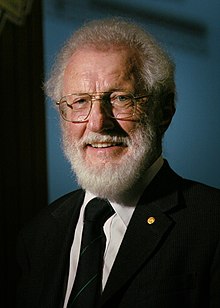

Herbert Kroemer
| |
|---|---|

Kroemer in 2008
| |
| Born | (1928-08-25)August 25, 1928 |
| Died | March 8, 2024(2024-03-08) (aged 95) |
| Nationality | Germany United States |
| Alma mater | University of Jena University of Göttingen |
| Known for | Drift-field transistor Double-heterostructure laser Heterojunction bipolar transistor |
| Awards | J J Ebers Award (1973) Humboldt Research Award (1994) Nobel Prize in Physics (2000) IEEE Medal of Honor[1](2002) |
| Scientific career | |
| Fields | Electrical Engineering, Applied Physics |
| Institutions | Fernmeldetechnisches Zentralamt RCA Laboratories Varian Associates University of Colorado University of California, Santa Barbara |
| Thesis | Zur Theorie des Germaniumgleichrichters und des Transistors : Ausz. Mit 10 Fig. im Text (1953) |
| Doctoral advisor | Fritz Sauter |
Herbert Kroemer (German: [ˈhɛʁbɛʁt ˈkʁøːmɐ] ⓘ; August 25, 1928 – March 8, 2024) was a German-American physicist who, along with Zhores Alferov, received the Nobel Prize in Physics in 2000 for "developing semiconductor heterostructures used in high-speed- and opto-electronics". Kroemer was professor emeritus of electrical and computer engineering at the University of California, Santa Barbara, having received his Ph.D. in theoretical physics in 1952 from the University of Göttingen, Germany, with a dissertation on hot electron effects in the then-new transistor.[2] His research into transistors was a stepping stone to the later development of mobile phone technologies.
Born to a working-class family in Weimar, Germany, Kroemer excelled in physics at school, letting him advance faster than his peers in the subject.[3]
Kroemer worked in a number of research laboratories in Germany and the United States and taught electrical engineering at the University of Colorado from 1968 to 1976. He joined the UCSB faculty in 1976, focusing its semiconductor research program on the emerging compound semiconductor technology rather than on mainstream silicon technology. Along with Charles Kittel he co-authored the textbook Thermal Physics, first published in 1980, and still used today. He is also the author of the textbook Quantum Mechanics for Engineering, Materials Science and Applied Physics.[4]
Kroemer was elected as a member into the National Academy of Engineering in 1997 for conception of the semiconductor heterostructure transistor and laser, and for leadership in semiconductor materials technology. He was also elected a member of the National Academy of Sciences in 2003.
Kroemer always preferred to work on problems that are ahead of mainstream technology, inventing the drift transistor in the 1950s and being the first to point out that advantages could be gained in various semiconductor devices by incorporating heterojunctions. Most notably, though, in 1963 he proposed the concept of the double-heterostructure laser, which is now a central concept in the field of semiconductor lasers. Kroemer became an early pioneer in molecular beam epitaxy, concentrating on applying the technology to untried new materials.
Kroemer was an atheist.[5] He died on March 8, 2024, at the age of 95.[6][7][8][9]
|
2000 Nobel Prize laureates
| |
|---|---|
| Chemistry |
|
| Literature (2000) |
|
| Peace |
|
| Physics |
|
| Physiology or Medicine |
|
| Economic Sciences |
|
| |
|
| |
|---|---|
| 2001–2025 |
|
| International |
|
|---|---|
| National |
|
| Academics |
|
| Other |
|